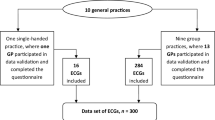Abstract
Electrocardiograms (ECGs) are frequently ordered in the pediatric emergency department (ED). Pediatric cardiologists are generally not asked to interpret every ECG; thus, ED patient management is often guided by the ED physicians’ ECG interpretation. The objective of this study was to analyze the accuracy of ECG interpretation by ED physicians and a computer-generated interpretation and compare the two. A 12-month prospective study was performed in a pediatric ED. All patients (<22 years) who had an ECG in the ED were included. The ED physicians and the computer interpretation were compared to a reference standard. Each electrocardiographic diagnosis, as well as the ECG as a whole, was assigned to one of the following predetermined classes: I, normal sinus rhythm; II, minimal clinical significance; III, indeterminate clinical significance; IV, those of definite clinical significance. Both groups correctly interpreted all normal (class I) ECGs. The computer correctly interpreted approximately 75% of the class II and class III ECGs, whereas the ED physicians correctly interpreted 36% of both groups. For the class IV ECGs, both the computer and the ED physicians performed poorly, correctly interpreting just 14% and 28%, respectively. The computer proved to be more accurate than the ED physicians in interpreting ECGs of less than critical significance (classes II and III), but neither group was able to correctly interpret even a simple majority of the most significant abnormalities (class IV). We speculate that distributing the computer-generated interpretation to the ED physicians and formal review of all ED ECGs by a skilled interpreter may decrease the number of missed diagnoses.
Similar content being viewed by others
References
MR Bell RJ Kozak (1996) ArticleTitleSeizures and the long-QT syndrome. Ann Emergency Med 28 556–560 Occurrence Handle1:STN:280:ByiD28rnvFw%3D
T Bradley J Dixon R Easthope (1999) ArticleTitleUnexplained fainting, near drowning and unusual seizures in childhood: screening for long QT syndrome in New Zealand families. NZ Med J 112 299–302 Occurrence Handle1:STN:280:DyaK1MvitFWksA%3D%3D
AM Davis JL Wilkinson (1998) ArticleTitleThe long QT syndrome and seizures in childhood. J Paediatr Child Health 34 410–411 Occurrence Handle10.1046/j.1440-1754.1998.00274.x Occurrence Handle1:STN:280:DyaK1cvktVWnsg%3D%3D Occurrence Handle9767499
J Fouron R Chicoine (1971) ArticleTitleECG changes in fetal imipramine (Tofranil) intoxication. Pediatrics 48 777–781 Occurrence Handle1:STN:280:CS2D2cngsVM%3D Occurrence Handle5121238
EM Harris JF Knapp V Sharma (1992) ArticleTitleThe Romano–Ward syndrome: a case presenting as near drowning with a clinical review. Pediatr Emergency Care 8 272–275 Occurrence Handle1:STN:280:ByyD38jmtlE%3D
LA Horton S Mosee J Brenner (1994) ArticleTitleUse of the electrocardiogram in a pediatric emergency department. Arch Pediatr Adolesc Med 148 184–188 Occurrence Handle1:STN:280:ByuC28zjtFI%3D Occurrence Handle8118538
A Ludomirsky H Klein E Kaplinsky (1982) ArticleTitleQT prolongation and polymorphous ventricular arrhythmias associated with organophorous insecticide poisoning. Am J Cardiol 49 1654–1658 Occurrence Handle1:STN:280:Bi2B3czhtVE%3D Occurrence Handle7081053
VR Pilapil DG Watson (1970) ArticleTitleThe electrocardiogram in hyperthyroid children. Am J Dis Child 119 245–248 Occurrence Handle1:STN:280:CS%2BC3MzisFM%3D Occurrence Handle5414814
ER Snoey B Housset P Guyon et al. (1994) ArticleTitleAnalysis of emergency department interpretation of electrocardiograms. J Accidental Emergency Med 11 149–153 Occurrence Handle1:STN:280:ByqC3czgtVY%3D
B Surawicz (1967) ArticleTitleRelationship between the electrocardiogram and electrolytes. Am Heart J 73 814–825 Occurrence Handle1:CAS:528:DyaF2sXksFWku7w%3D Occurrence Handle5338052
K Todd J Hoffman M Morgan (1996) ArticleTitleEffect of cardiologist ECG review on emergency department practice. Ann Emergency Med 27 16–21 Occurrence Handle1:STN:280:BymC2c3htFw%3D
D Woolley M Henck J Luck (1992) ArticleTitleComparison of electrocardiogram interpretations by family physicians, a computer, and a cardiology service. J Family Practice 34 428–432 Occurrence Handle1:STN:280:By2B3M7jtVU%3D
Author information
Authors and Affiliations
Rights and permissions
About this article
Cite this article
Snyder, C., Fenrich, A., Friedman, R. et al. The Emergency Department Versus the Computer: Which Is the Better Electrocardiographer? . Pediatr Cardiol 24, 364–368 (2003). https://doi.org/10.1007/s00246-002-0332-z
Published:
Issue Date:
DOI: https://doi.org/10.1007/s00246-002-0332-z




